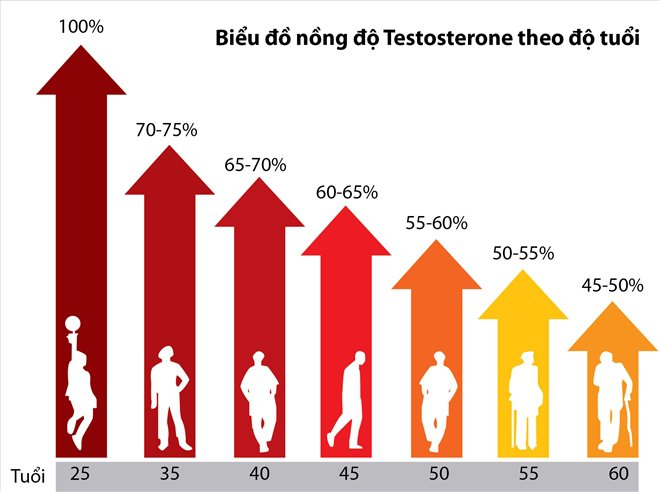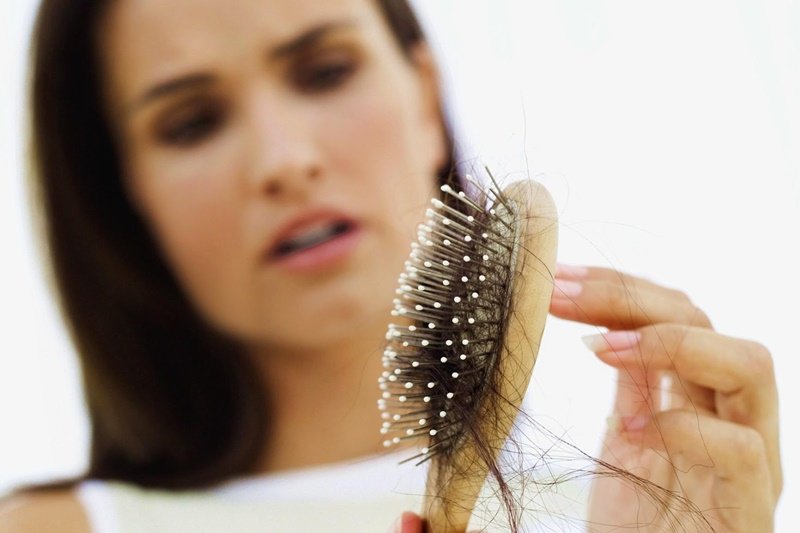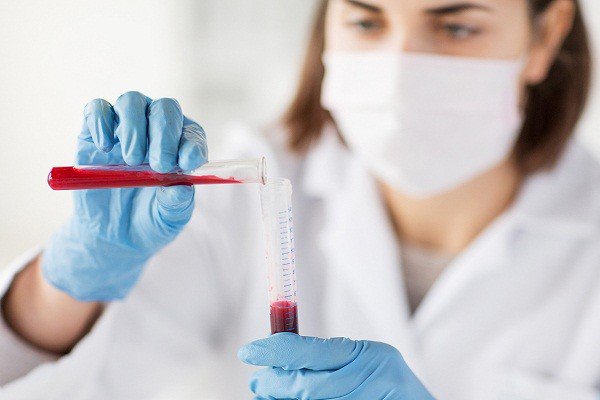Determination of testosterone according to age
This is an automatically translated article.
Testosterone is a powerful hormone for both men and women. It has the ability to control sex life, regulate sperm production, promote muscle growth and boost energy. Along with age, the level of testosterone in the body gradually decreases. This can lead to a variety of changes such as decreased sex drive. While lower testosterone levels may be involved, it is a natural part of aging.
1. How much testosterone is normal?

Mức độ testosterone phụ thuộc theo độ tuổi.
“Normal” or healthy levels of testosterone in the blood vary widely, depending on thyroid function, protein status, and other factors.
According to recent guidelines from the American Urological Association (AUA), a testosterone level of at least 300 nanograms per deciliter (ng/dL) is normal for a man. A man with a testosterone level below 300 ng/dL is diagnosed with low testosterone. For women 19 and older, normal testosterone levels range from 8 to 60 ng/dL, according to the Mayo Clinic Laboratories. Testosterone levels peak around age 18 or 19 before gradually declining throughout the rest of adulthood. In the womb, Testosterone is required for the normal development of the fetus during pregnancy. It controls the development of the male reproductive system. According to a study of 60 children, testosterone levels in the womb can also affect the baby's right and left brain function. Testosterone levels must be within a very narrow range for the brain of the fetus to be healthy. High fetal testosterone levels may be linked to autism. From adolescence to early adulthood, testosterone levels are at their highest during adolescence and early adulthood. In boys, the first physical signs of testosterone, or androgens, in the body are very evident during puberty. A boy's voice changes, his shoulders widen and his facial structure becomes more masculine. In adulthood, as men age, their testosterone levels can drop by about 1% per year after age 30. In premenopausal women, testosterone is made mainly in the ovaries. Levels drop after menopause, which usually begins between the ages of 45 and 55.
According to recent guidelines from the American Urological Association (AUA), a testosterone level of at least 300 nanograms per deciliter (ng/dL) is normal for a man. A man with a testosterone level below 300 ng/dL is diagnosed with low testosterone. For women 19 and older, normal testosterone levels range from 8 to 60 ng/dL, according to the Mayo Clinic Laboratories. Testosterone levels peak around age 18 or 19 before gradually declining throughout the rest of adulthood. In the womb, Testosterone is required for the normal development of the fetus during pregnancy. It controls the development of the male reproductive system. According to a study of 60 children, testosterone levels in the womb can also affect the baby's right and left brain function. Testosterone levels must be within a very narrow range for the brain of the fetus to be healthy. High fetal testosterone levels may be linked to autism. From adolescence to early adulthood, testosterone levels are at their highest during adolescence and early adulthood. In boys, the first physical signs of testosterone, or androgens, in the body are very evident during puberty. A boy's voice changes, his shoulders widen and his facial structure becomes more masculine. In adulthood, as men age, their testosterone levels can drop by about 1% per year after age 30. In premenopausal women, testosterone is made mainly in the ovaries. Levels drop after menopause, which usually begins between the ages of 45 and 55.
2. Signs and symptoms of low testosterone levels

Thiếu sức sống là một triệu chứng điển hình của suy giảm testosterone.
To measure testosterone, doctors will order a blood test. Some people are born with causes of low testosterone levels. Testosterone can also drop if you have a medical condition that affects your testicles or ovaries, which are hormone-producing organs.
Testosterone secretion usually decreases with age. According to the American Urological Association, about 2 out of 10 men over the age of 60 have low testosterone levels. This number increases slightly to 3 out of 10 men in their 70s and 80s.
As you age, testosterone levels decrease. However, the U.S. Food and Drug Administration (FDA) advises against taking testosterone replacement therapy (TRT) for low levels that are caused solely by aging.
Low testosterone levels can cause changes in sexual function, including:
Decreased libido, or low sex drive. Less natural erection. Impotence Erectile dysfunction (ED). Infertility . Other signs of low testosterone levels include:
Difficulty concentrating. Lifeless. Reduced muscle mass and strength. Reduced bone density. Increase breast size in men. Depression . Tired. Change sleep. Please go to the doctor and do tests as prescribed by experts when you feel that your body is having problems.
Testosterone secretion usually decreases with age. According to the American Urological Association, about 2 out of 10 men over the age of 60 have low testosterone levels. This number increases slightly to 3 out of 10 men in their 70s and 80s.
As you age, testosterone levels decrease. However, the U.S. Food and Drug Administration (FDA) advises against taking testosterone replacement therapy (TRT) for low levels that are caused solely by aging.
Low testosterone levels can cause changes in sexual function, including:
Decreased libido, or low sex drive. Less natural erection. Impotence Erectile dysfunction (ED). Infertility . Other signs of low testosterone levels include:
Difficulty concentrating. Lifeless. Reduced muscle mass and strength. Reduced bone density. Increase breast size in men. Depression . Tired. Change sleep. Please go to the doctor and do tests as prescribed by experts when you feel that your body is having problems.
3. Testosterone and women
Testosterone is the main hormone of men, but women also need it to function properly. Testosterone levels in women are much lower than in men.
A woman's estrogen levels drop after she enters menopause. This can make a woman's level of male hormones, also known as androgens, somewhat higher. Conditions such as polycystic ovary syndrome (PCOS) can also increase testosterone levels.
Excess testosterone in female blood can cause:
Baldness. Acne. Menstrual irregularities or amenorrhea. Hair growth on facial skin. Infertility Low testosterone in women can also cause fertility problems, along with weak bones and decreased libido.
4. Testing and Diagnosis
The best way to diagnose low testosterone is to visit your doctor for a clinical examination and blood tests.
The doctor will review the appearance and sexual development. Since testosterone levels are typically higher in the morning, blood tests should be done before 10:00 a.m. in young men. Tests performed on men over 45 years of age can take as long as 2:00 p.m. and still get accurate results.
Effects of abnormal testosterone levels
Although symptoms of low testosterone can be a normal part of aging, they can also be a sign of other underlying factors, including:
Reactions to some drugs. Thyroid disorders. Depression. Alcohol abuse. Lower than normal testosterone levels can be caused by the following:
Ovarian or testicular cancer. Testicular failure. Hypogonadism, a condition whereby the sex glands produce little or no hormone. Puberty early or late. Chronic illness, such as diabetes or kidney disease. Severe obesity. Chemotherapy or radiation therapy. Use of opioid pain relievers. Genetic conditions present at birth, like Klinefelter syndrome. Testosterone levels above the normal range can be caused by:
PCOS polycystic ovary syndrome. Congenital adrenal hyperplasia (CAH) in women. Testicular or adrenal tumor. Unlike women, who experience a rapid drop in hormone levels at menopause, men experience a gradual decrease in testosterone levels over time. For men, the older they get, the lower their testosterone levels become. Men with testosterone levels below 300 ng/dL may experience some degree of symptoms of low testosterone levels. Your doctor can order blood tests and recommend treatment if needed. Doctors will also explain the potential benefits and risks of testosterone pills.
The doctor will review the appearance and sexual development. Since testosterone levels are typically higher in the morning, blood tests should be done before 10:00 a.m. in young men. Tests performed on men over 45 years of age can take as long as 2:00 p.m. and still get accurate results.
Effects of abnormal testosterone levels
Although symptoms of low testosterone can be a normal part of aging, they can also be a sign of other underlying factors, including:
Reactions to some drugs. Thyroid disorders. Depression. Alcohol abuse. Lower than normal testosterone levels can be caused by the following:
Ovarian or testicular cancer. Testicular failure. Hypogonadism, a condition whereby the sex glands produce little or no hormone. Puberty early or late. Chronic illness, such as diabetes or kidney disease. Severe obesity. Chemotherapy or radiation therapy. Use of opioid pain relievers. Genetic conditions present at birth, like Klinefelter syndrome. Testosterone levels above the normal range can be caused by:
PCOS polycystic ovary syndrome. Congenital adrenal hyperplasia (CAH) in women. Testicular or adrenal tumor. Unlike women, who experience a rapid drop in hormone levels at menopause, men experience a gradual decrease in testosterone levels over time. For men, the older they get, the lower their testosterone levels become. Men with testosterone levels below 300 ng/dL may experience some degree of symptoms of low testosterone levels. Your doctor can order blood tests and recommend treatment if needed. Doctors will also explain the potential benefits and risks of testosterone pills.
Please dial HOTLINE for more information or register for an appointment HERE. Download MyVinmec app to make appointments faster and to manage your bookings easily.
Articles by source Healthline
This article is written for readers from Sài Gòn, Hà Nội, Hồ Chí Minh, Phú Quốc, Nha Trang, Hạ Long, Hải Phòng, Đà Nẵng.




